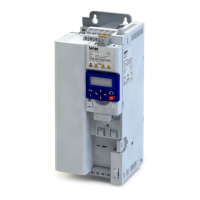7.6 "Switch-o posioning" stop mode
This stopping method is an extension of the stopping method "Standard ramp". A relavely
consistent stop posion can be achieved regardless of the current motor speed aer a stop
command using the "switch-o posioning". In this case, depending on the current output
frequency, the inverter delays the beginning of the down-ramping so that the number of
motor revoluons is always the same from the stop command to standsll.
Details
Select the stop method. 0x2838:003 (P203.03) 4Stopping performance ^ 46
The number of motor revoluons to standsll depends on the rated speed of the motor, the
set deceleraon me and the set maximum frequency.
Example calculaon:
•
4-pole 50 Hz motor with rated speed = 1500 rpm
•
Maximum frequency 0x2916 (P211.00) = 50.0 Hz
•
Deceleraon me 1 0x2918 (P221.00) = 10.0 s
+ =
t
0 Hz
30 Hz
10 Hz
20 Hz
40 Hz
50 Hz
60 Hz
t
t
0 Hz
30 Hz
10 Hz
20 Hz
40 Hz
50 Hz
60 Hz
t
0x2918 0x2918
10 s
1 52
24 s 2 s
120
5+ =
3 0 rpm0
1 00 rpm5
0x2DDD
0x2916
1 52
26 s
= 30 revolutions/s
= Revolutions/s5
Motor revolutions:
Time:
Digital input 1 [11] Run
Constant TRUE
Output signals
Output frequency
Enable inverter
Input signals
Frequency setpoint selection
FunctionTrigger
①
The motor is immediately brought to a standsll with the set deceleraon me following a stop command if the output frequency corre-
sponds to the set maximum frequency.
In the example, the motor reaches a standsll aer 125 revoluons.
②
If the current output frequency is less than the maximum frequency, the inverter delays the beginning of the down-ramping in order to
reach the same number of motor revoluons to standsll, depending on the current output frequency.
In the example, the down-ramping is iniated with a delay of 24 seconds in order to reach the number of 125 motor revoluons to a
standsll.
Conguring the frequency control
"Switch-o posioning" stop mode
146

